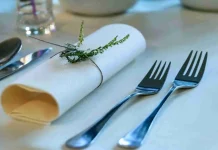These special knives are originated in Japan and are specifically used for chopping and slicing vegetables. The shape is much like a meat chopper with its straight spine and belly, wide heel, and flat tip parallel to the heel.
The nakiri can be a fascinating choice for many newcomers to Japanese kitchen knives. About 10 years ago, I still remember when I first saw nakiri in Knifewear Calgary. I was searching for a second option to adjust with my 240mm gyuto and was attracted by the square shape that I thought was a meat chopper.
It is a Japanese-style knife that resembles a chef’s knife. It has a symmetrical, straight wide blade with a blunt nose. Nakiri knives also known as aka nakiri knives are traditional Japanese knives.
Naukri boho means knife to cut greens. It is mainly used to mince, slice, and chop vegetables and can also be used on fruits.
In this article, we will focus on the Nakiri knife and its uses. Let’s start.
What are the features of a Nakiri Knife?
You can recognize a nakiri knife based on several features. The main points to consider are:
1. Size and shape
The knives are rectangular and long, varying from 120mm-210mm. But knives measuring 165mm or 180mm are mostly preferred.
As you use the knife, the tall length provides excellent clearance of knuckles that enhances your comfort.
Moreover, the shape gives a different advantage to the knife, even on sharpening the length remains the same.
2. Type of edge
Unlike its closest compatriot, the usuba knife, the nakiri knife is a double-beveled knife. A double bevel means on all two sides, the blade is ground giving you acute cuts and a balanced cut.
Unlike a single bevel knife that requires left-handed people at a higher price, to buy another knife, it lets both the right and left-handed use the knife.
3. The handle
The handle plays a significant role in your ease and the speed of your cutting. It also affects the aesthetics and balance of the whole knife. Usually, Nakiri knives have two main handle types, the Japanese ‘was handled’ or western-style type of handle.
The shapes of the knives are different too. The selection of handle depends on your choice, and it assists to select an ergonomic handle for comfort and safety.
How do you use a Nakiri Knife?
As long as you have a cutting board, the magic of cutting with the nakiri knife makes you ready to become a professional and expert chef. Now all you have to know is how to sharpen a knife and what kind of cut to make with the nakiri knife.
Cutting with a nakiri knife depends on a straight up and down chop. Along with that, you can slide backward and forwards as your arm is still using upward and downward movement. The Nakiri knife is great for precise cuts of vegetables unlike cutting with other knives so the up and down movement is all that you require and more.
The comparison between home kitchens and professional kitchens is how well the person manages and maintains their equipment.
Nakiri Vs Usuba Knife
Nakiri knife and Usuba are the same, and if you don’t have an idea about the main difference among them, actually you would consider them the same.
The Usuba, like the Nakiri, is a Japanese-style knife that has a straight edge and square tip. The Usuba is a single beveled whereas, the Nakiri is beveled. As compared to the Nakiri, the Usuba is heavier, thicker, and longer.
Due to the single beveled edge, the Usuba can for more delicate work and is used mostly by professional chefs.
What to cut with a Nakiri Knife
After getting an idea of using Nakiri, now you are able to know what foods are best to cut with this knife. The knife is not a meat chopper. This knife is meant for fruit and vegetables.
The list of items are
- Zucchini and other summer squash
- Mushrooms
- All kinds of potatoes
- Cucumber
- Tomatoes
- Peppers
- Pineapple
- Cabbage
- All kinds of melons
- Pears, apples, lemons, limes, and oranges
Why do I need one?
The nakiri knife in my kitchen is used in place of “Sous chef” to my big 244mm gyuto. The gyuto always take a charge, however, nakiri always saves me in heavy-duty prep work. It is not a big deal to slice up 10 onions for soup? The nakiri knife manages the work in no time.
Similar to a chef’s knife, your nakiri knife can be very useful. They easily handle little tasks such as chopping herbs and minced garlic. This is the best knife you need if you only cut vegetables or you are a vegan.
Advantages of a Nakiri Knife
Why do chefs like to use nakiri knives in the kitchen for cutting vegetables? The several benefits are
- Fast and fluid chopping
- Excellent for delicate vegetables
- Fluid and fast chopping
- Right length size
- Double bevel
- Usable from tip to tail
The Bottom Line
When it comes to cutting vegetables and fruits, Nakiri knives are the best. The only challenge is people find it difficult where to buy it. The Nakiri knife is excellent for cutting and chopping all kinds of vegetables. Many people are unfamiliar with this helpful kitchen gadget. Once you get it this is the most helpful Japanese knife in the kitchen.












